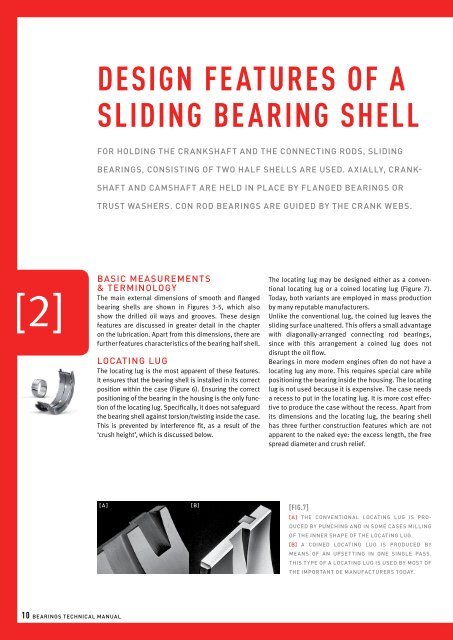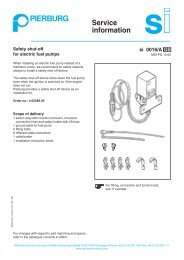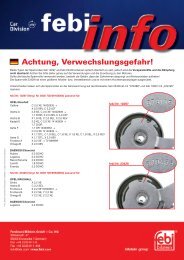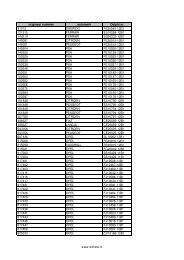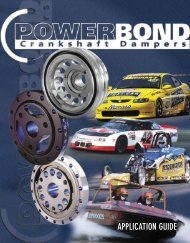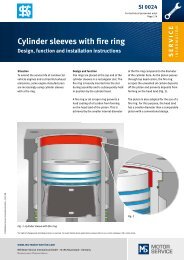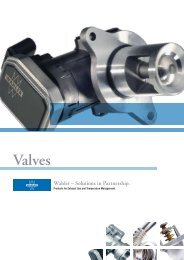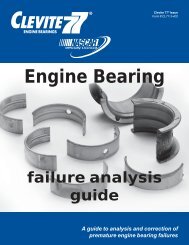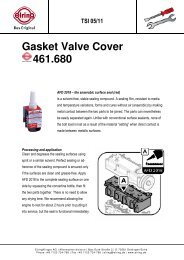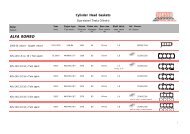EvEry bEaring you nEEd
EvEry bEaring you nEEd
EvEry bEaring you nEEd
Create successful ePaper yourself
Turn your PDF publications into a flip-book with our unique Google optimized e-Paper software.
Design features of a<br />
sliding bearing shell<br />
[2]<br />
[10]<br />
[4]<br />
[1]<br />
[9]<br />
[6]<br />
[8]<br />
[7]<br />
[fig.3] dimensions and characteristics<br />
of an engine bearing<br />
[1] outer diameter<br />
[2] bearing length<br />
[3] wall thickness<br />
[4] sliding surface<br />
[5] oil bore<br />
[6] length of locating lug<br />
[7] width of locating lug<br />
For holding the crankshaft and the connecting rods, sliding<br />
bearings, consisting of two half shells are used. Axially, crank-<br />
[5]<br />
[3]<br />
[11]<br />
[8] depth of locating lug<br />
[9] lug relief<br />
[10] partial oil groove<br />
[11] bearing back<br />
shaft and camshaft are held in place by flanged bearings or<br />
trust washers. Con rod bearings are guided by the crank webs.<br />
[1]<br />
[2]<br />
[4]<br />
[3]<br />
[10]<br />
[9]<br />
[6]<br />
[fig.4] characteristics of an assembled flange bearing<br />
[1] length<br />
[2] flange distance<br />
[3] flange wall thickness<br />
[4] stress reduction relieves<br />
[2]<br />
Basic measurements<br />
& terminology<br />
The main external dimensions of smooth and flanged<br />
bearing shells are shown in Figures 3-5, which also<br />
show the drilled oil ways and grooves. These design<br />
features are discussed in greater detail in the chapter<br />
on the lubrication. Apart from this dimensions, there are<br />
further features characteristics of the bearing half shell.<br />
Locating lug<br />
The locating lug is the most apparent of these features.<br />
It ensures that the bearing shell is installed in its correct<br />
position within the case (Figure 6). Ensuring the correct<br />
positioning of the bearing in the housing is the only function<br />
of the locating lug. Specifically, it does not safeguard<br />
the bearing shell against torsion/twisting inside the case.<br />
This is prevented by interference fit, as a result of the<br />
‘crush height’, which is discussed below.<br />
The locating lug may be designed either as a conventional<br />
locating lug or a coined locating lug (Figure 7).<br />
Today, both variants are employed in mass production<br />
by many reputable manufacturers.<br />
Unlike the conventional lug, the coined lug leaves the<br />
sliding surface unaltered. This offers a small advantage<br />
with diagonally-arranged connecting rod bearings,<br />
since with this arrangement a coined lug does not<br />
disrupt the oil flow.<br />
Bearings in more modern engines often do not have a<br />
locating lug any more. This requires special care while<br />
positioning the bearing inside the housing. The locating<br />
lug is not used because it is expensive. The case needs<br />
a recess to put in the locating lug. It is more cost effective<br />
to produce the case without the recess. Apart from<br />
its dimensions and the locating lug, the bearing shell<br />
has three further construction features which are not<br />
apparent to the naked eye: the excess length, the free<br />
spread diameter and crush relief.<br />
clinch<br />
[5]<br />
[8]<br />
[7]<br />
[5] joint relief of thrust face<br />
[6] locating lug<br />
[7] joint relief of thrust face<br />
[8] oil bore<br />
[9] oil groove<br />
[10] joint relief of sliding surface<br />
[fig.5]<br />
characteristics of an assembled flange bearing.<br />
for dimensions see fig. 4.<br />
locating lug<br />
parting face<br />
[A]<br />
[b]<br />
[fig.7]<br />
[A] The conventional locating lug is pro-<br />
recess<br />
[fig.6]<br />
The only purpose of the locating lug of a bearing<br />
is to avoid the bearing being assembled in an<br />
duced by punching and in some cases milling<br />
incorrect position into the housing. The housing<br />
of the inner shape of the locating lug.<br />
bore has a recess in which the locating lug fits.<br />
[b] A coined locating lug is produced by<br />
The locating lug does not prevent the bearing<br />
means of an upsetting in one single pass.<br />
from turning in the housing.<br />
This type of a locating lug is used by most of<br />
the important OE manufacturers today.<br />
10 Bearings Technical Manual<br />
11


